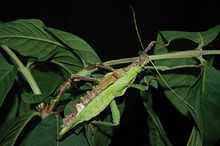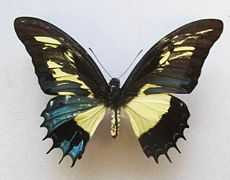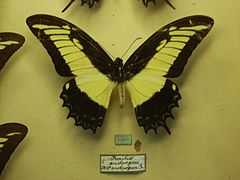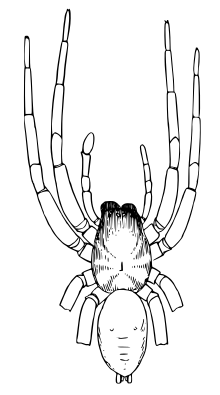Gynandromorphism

_gynandromorphe.jpg)
A gynandromorph is an organism that contains both male and female characteristics. The term gynandromorph, from Greek "gyne" female and "andro" male, is mainly used in the field of entomology. These characteristics can be seen in butterflies, where both male and female characteristics can be seen physically because of sexual dimorphism. Cases of gynandromorphism have also been reported in crustaceans, especially lobsters, sometimes crabs and even in birds.[1][2][3][4] A clear example in birds is the gynandromorphic zebra finch. These birds have lateralised brain structures in the face of a common steroid signal, providing strong evidence for a non-hormonal primary sex mechanism regulating brain differentiation.[5]
A gynandromorph can have bilateral asymmetry, one side female and one side male,[6] or they can be mosaic, a case in which the two sexes aren't defined as clearly.
Bilateral gynandromorphy arises very early in development, typically when the organism has between 8 and 64 cells.[7] Later the gynandromorph is mosaic.
The cause of this phenomenon is typically, but not always, an event in mitosis during early development. While the organism is only a few cells large, one of the dividing cells does not split its sex chromosomes typically. This leads to one of the two cells having sex chromosomes that cause male development and the other cell having chromosomes that cause female development. For example, an XY cell undergoing mitosis duplicates its chromosomes, becoming XXYY. Usually this cell would divide into two XY cells, but in rare occasions the cell may divide into an X cell and an XYY cell. If this happens early in development, then a large portion of the cells are X and a large portion are XYY. Since X and XYY dictate different sexes, the organism has tissue that is female and tissue that is male.[8]
A developmental network theory of how gynandromorphs develop from a single cell based on internetwork links between parental allelic chromosomes is given in.[9] The major types of gynandromorphs, bilateral, polar and oblique are computationally modeled. Many other possible gynandromorph combinations are computationally modeled, including predicted morphologies yet to be discovered. The article relates gynandromorph developmental control networks to how species may form. The models are based on a computational model of bilateral symmetry.[10]
In his autobiography, Speak, Memory, the writer and lepidopterist Vladimir Nabokov describes a gynandromorph butterfly, male on one side, female on the other, that he caught as a youth on his family's Russian estate.[11]
Chickens can also be gynandromorphous.[12]
-

Normal female of Papilio androgeus
-

Mosaic gynandromorph of Papilio androgeus
-

Normal male of Papilio androgeus
See also
- Androgyny
- Bilateral symmetry
- Chimerism
- Gynomorph
- Hermaphrodite
- Intersex
- Shemale
References
- ↑ Chen, Xuqi; Agate, Robert J.; Itoh, Yuichiro; Arnold, Arthur P. (2005). "Sexually dimorphic expression of trkB, a Z-linked gene, in early posthatch zebra finch brain". Proceedings of the National Academy of Sciences 102 (21): 7730–5. doi:10.1073/pnas.0408350102. PMC 1140405. PMID 15894627. Lay summary – Scientific American (March 25, 2003).
- ↑ Gouldian Finch Erythrura gouldiae Gynandromorph
- ↑ Powderhill Banding Fall 2004
- ↑ A Gender-bender Colored Cardinal, by Tim Wall, Discovery News, 31 May 2011
- ↑ Arnold, Arthur P. (2004). "Sex chromosomes and brain gender". Nature Reviews Neuroscience 5 (9): 701–8. doi:10.1038/nrn1494. PMID 15322528.
- ↑ Ian Sample, science correspondent (12 July 2011). "Half male, half female butterfly steals the show at Natural History Museum". London: The Guardian. Retrieved August 6, 2011.
- ↑ Malmquist, David (June 15, 2005). "Rare crab may hold genetic secrets". Virginia Institute of Marine Science.
- ↑ Adams, James K. "Gynandromorphs". Department of Natural Sciences, Dalton State College.
- ↑ Werner, Eric (2012). "A Developmental Network Theory of Gynandromorphs, Sexual Dimorphism and Species Formation". arXiv:1212.5439 [q-bio.MN].
- ↑ Werner, Eric (2012). "The Origin, Evolution and Development of Bilateral Symmetry in Multicellular Organisms". arXiv:1207.3289 [q-bio.TO].
- ↑ Nabokov, Vladimir (1967). Speak, Memory. New York: Alfred A. Knopf. p. 97.
- ↑ "Half-cock chicken mystery solved". BBC News. 11 March 2010.
| Wikimedia Commons has media related to Gynandromorphs. |
